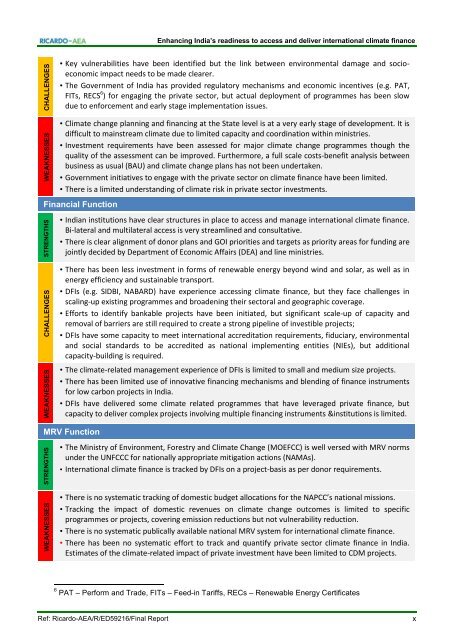Enhancing India’s Readiness to Climate Finance
India has taken several steps to improve its national response to climate change. India’s climate finance requirements, however, are very high, and will need to be met through a combination of public, private and international climate finance. See more at: http://shaktifoundation.in/
India has taken several steps to improve its national response to climate change. India’s climate finance requirements, however, are very high, and will need to be met through a combination of public, private and international climate finance. See more at: http://shaktifoundation.in/
- No tags were found...
You also want an ePaper? Increase the reach of your titles
YUMPU automatically turns print PDFs into web optimized ePapers that Google loves.
CHALLENGES<br />
WEAKNESSES<br />
CHALLENGES<br />
WEAKNESSES<br />
WEAKNESSES<br />
STRENGTHS<br />
STRENGTHS<br />
<strong>Enhancing</strong> <strong>India’s</strong> readiness <strong>to</strong> access and deliver international climate finance<br />
• Key vulnerabilities have been identified but the link between environmental damage and socioeconomic<br />
impact needs <strong>to</strong> be made clearer.<br />
• The Government of India has provided regula<strong>to</strong>ry mechanisms and economic incentives (e.g. PAT,<br />
FITs, RECS 6 ) for engaging the private sec<strong>to</strong>r, but actual deployment of programmes has been slow<br />
due <strong>to</strong> enforcement and early stage implementation issues.<br />
• <strong>Climate</strong> change planning and financing at the State level is at a very early stage of development. It is<br />
difficult <strong>to</strong> mainstream climate due <strong>to</strong> limited capacity and coordination within ministries.<br />
• Investment requirements have been assessed for major climate change programmes though the<br />
quality of the assessment can be improved. Furthermore, a full scale costs-benefit analysis between<br />
business as usual (BAU) and climate change plans has not been undertaken.<br />
• Government initiatives <strong>to</strong> engage with the private sec<strong>to</strong>r on climate finance have been limited.<br />
• There is a limited understanding of climate risk in private sec<strong>to</strong>r investments.<br />
Financial Function<br />
• Indian institutions have clear structures in place <strong>to</strong> access and manage international climate finance.<br />
Bi-lateral and multilateral access is very streamlined and consultative.<br />
• There is clear alignment of donor plans and GOI priorities and targets as priority areas for funding are<br />
jointly decided by Department of Economic Affairs (DEA) and line ministries.<br />
• There has been less investment in forms of renewable energy beyond wind and solar, as well as in<br />
energy efficiency and sustainable transport.<br />
• DFIs (e.g. SIDBI, NABARD) have experience accessing climate finance, but they face challenges in<br />
scaling-up existing programmes and broadening their sec<strong>to</strong>ral and geographic coverage.<br />
• Efforts <strong>to</strong> identify bankable projects have been initiated, but significant scale-up of capacity and<br />
removal of barriers are still required <strong>to</strong> create a strong pipeline of investible projects;<br />
• DFIs have some capacity <strong>to</strong> meet international accreditation requirements, fiduciary, environmental<br />
and social standards <strong>to</strong> be accredited as national implementing entities (NIEs), but additional<br />
capacity-building is required.<br />
• The climate-related management experience of DFIs is limited <strong>to</strong> small and medium size projects.<br />
• There has been limited use of innovative financing mechanisms and blending of finance instruments<br />
for low carbon projects in India.<br />
• DFIs have delivered some climate related programmes that have leveraged private finance, but<br />
capacity <strong>to</strong> deliver complex projects involving multiple financing instruments &institutions is limited.<br />
MRV Function<br />
• The Ministry of Environment, Forestry and <strong>Climate</strong> Change (MOEFCC) is well versed with MRV norms<br />
under the UNFCCC for nationally appropriate mitigation actions (NAMAs).<br />
• International climate finance is tracked by DFIs on a project-basis as per donor requirements.<br />
• There is no systematic tracking of domestic budget allocations for the NAPCC’s national missions.<br />
• Tracking the impact of domestic revenues on climate change outcomes is limited <strong>to</strong> specific<br />
programmes or projects, covering emission reductions but not vulnerability reduction.<br />
• There is no systematic publically available national MRV system for international climate finance.<br />
• There has been no systematic effort <strong>to</strong> track and quantify private sec<strong>to</strong>r climate finance in India.<br />
Estimates of the climate-related impact of private investment have been limited <strong>to</strong> CDM projects.<br />
6 PAT – Perform and Trade, FITs – Feed-in Tariffs, RECs – Renewable Energy Certificates<br />
Ref: Ricardo-AEA/R/ED59216/Final Report<br />
x

















